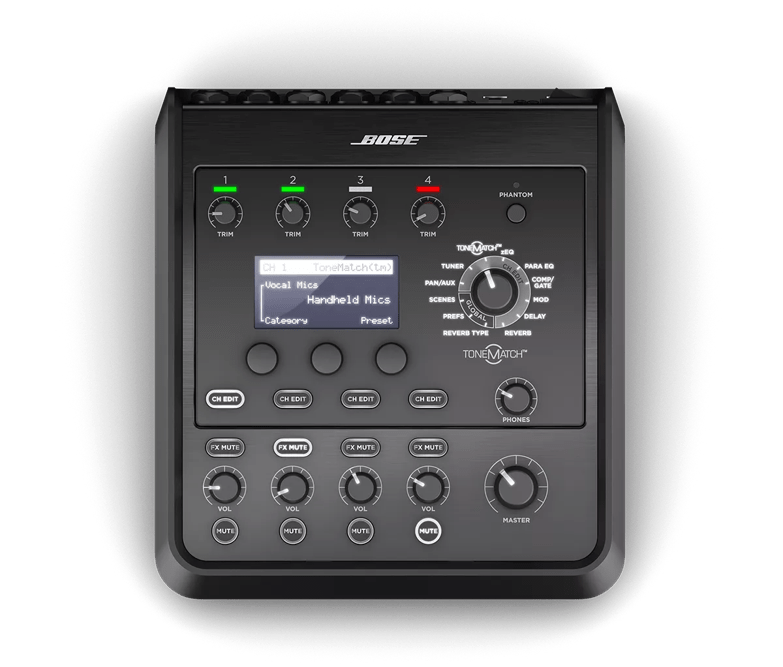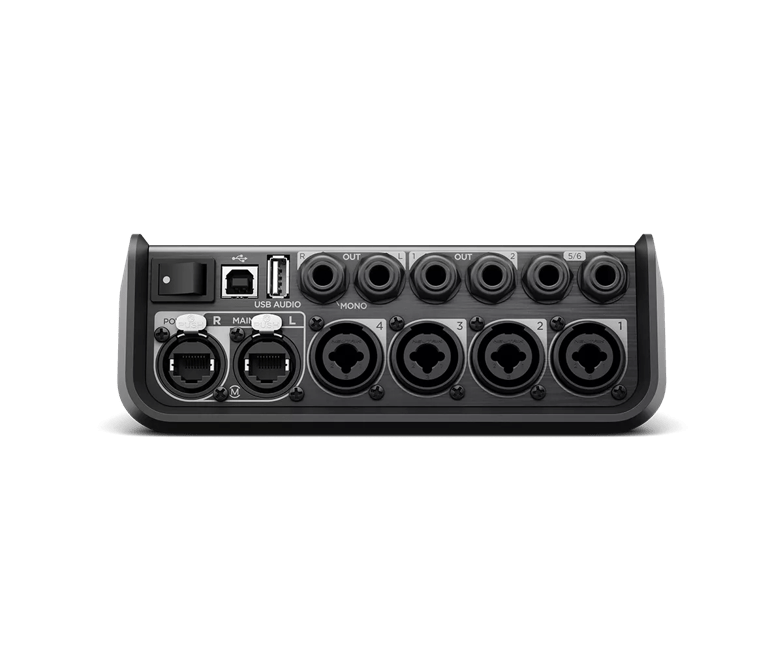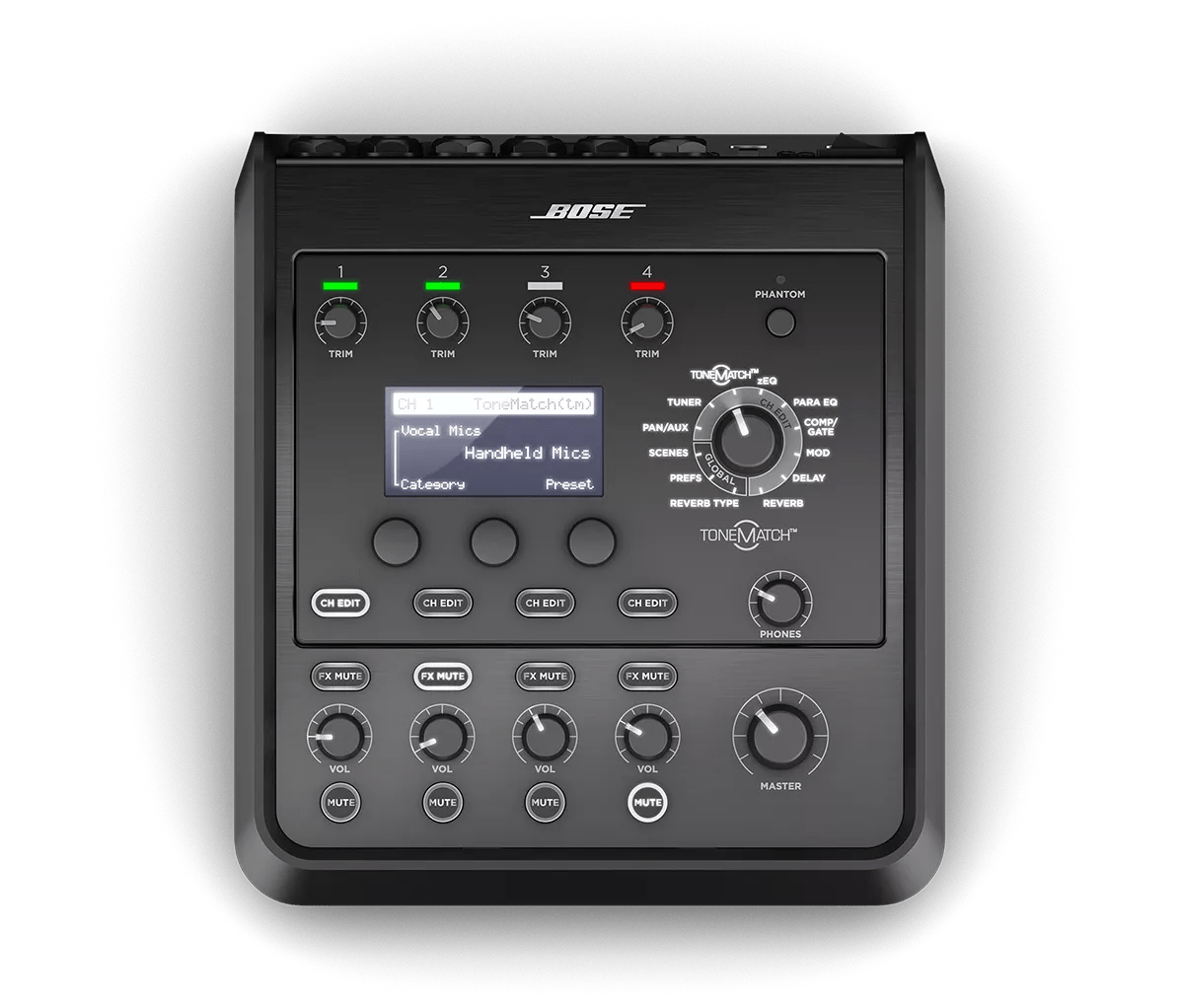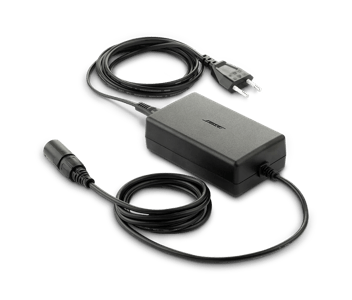

-
Powerful audio processing
-
Stay connected with any setup
-
Seamless sound control
-
Convenient features for any gig
T4S ToneMatch® mixer
-
Powerful audio processing
-
Stay connected with any setup
-
Seamless sound control
-
Convenient features for any gig
Price is: $699.00
Product details

- T4S ToneMatch mixer
- ToneMatch cable
- Cover
| Audio cable included | No |
|---|---|
| Entire Product System | 3.153 lb |
Take control of your music with T4S and T8S ToneMatch Mixers, compact 4- and 8-channel interfaces designed for performers. Engineered with powerful DSP engines and intuitive user controls, they offer studio-quality EQ, dynamics, and effects processing. Sound great with integrated Bose ToneMatch processing and zEQ, especially when connected to a Bose L1 or F1 System for full end-to-end tonal control. Play confidently on stage with these rugged ToneMatch Mixers using tactile controls, easy-to-read LED displays, and scene recall.
Powerful audio processing
Elevate your performances with updated, studio-quality effects and advanced digital audio processing. Never run out of options with channel-independent EQ, dynamics, and effects. Get your perfect sound fast with Bose ToneMatch processing for natural-sounding vocals and instruments, while zEQ focuses your tone for effective adjustments on the fly. When used with Bose L1 and F1 Systems, the T8S Mixer allows full end-to-end optimization of your sound.
Easy live streaming
A Bose T8S ToneMatch Mixer is the perfect audio interface for live streaming your performances on platforms like Facebook and Instagram Live. Connect easily to your Mac or PC with the onboard USB interface. Then use the studio-quality microphone pre-amps, phantom power, EQ, dynamics, and effects to take control of your sound and bring your live stream to life.
Seamless live control
The T8S integrates with your performance using illuminated, tactile controls and indicators for spontaneous sound adjustments, even on dimly lit stages. Jump into settings with the fast-learning, intuitive control interface. Additional features like tap tempo delay, built-in chromatic tuner, and recallable scenes make it easy to be ready to play. The T8S is the ultimate on-stage companion for performing artists.
High-density connectivity
For its size, the stereo T8S Mixer gives you unprecedented connectivity with control. Eight main channels feature high-quality audio preamps with XLR-combo jacks for microphones or instruments, and switchable phantom power. Additionally, the T8S offers four Aux sends, two Aux inputs, USB-A and -B for USB drive playback or PC/Mac interfacing, a dedicated headphone jack, and balanced ¼” TRS and XLR analog outputs.
Convenient gig-ready features
Rugged and ready to go, the T8S includes a ToneMatch universal power supply and a protective magnetic cover to protect controls and connectors. A bottom insert allows you to use standard mounting accessories to keep the T8S within reach.
The T4S and the T8S both have the same compact interface, tactile knobs, and advanced digital audio processing, yet the T8S gives you an expanded channel count with four more mic/line inputs and a total of four Aux sends. The T8S also includes an output meter to visually monitor your output level. The T4S can receive power and send digital audio to L1 Model II or L1 Model 1S products when using the included ToneMatch cable. The T8S comes standard with a universal power supply and does not offer a ToneMatch link.
ToneMatch presets are designed for specific instruments and microphones for use with the L1 Model 1S/II System, S1 Pro or F1 System. ToneMatch presets are available for each channel and instantly bring you closer to the true sound of your voice or instrument — all at the touch of a button. When you select a proprietary ToneMatch preset for your microphone or instrument, you are tapping into a powerful technology, available only from Bose.
Ordinary tone controls are generic by design: “High,” “Mid,” and “Low” controls are spread out across the entire musical spectrum. Proprietary zEQ automatically shifts the range of these controls so that they correspond directly to the range of your voice or instrument. zEQ gives you more precise control over your tone, making it easy to fine-tune your sound.
Adjust the output volume of the source instrument to normal operating volume, or sing into the microphone using your loudest level. Make sure that the Master volume and the channel volume on the T4S/T8S are set to 0. While playing your instrument/audio sources as loudly as you would during a performance, turn the trim control on applicable channel of the T4S/T8S clockwise until the signal/clip indicator glows green. If the indicator flashes red or glows steady red, turn the trim control counterclockwise to decrease the level until it’s most always green.
These are direct output signals that can be taken pre or post mix and connected to a number of different devices including personal monitors, amplifiers or recording devices. Aux outputs accept ¼" TRS balanced cables.
Inputs 1 – 4 (1 – 8 with the T8S) are analog input channels with a combination input connector. This connector supports either balanced XLR audio cables or ¼" balanced (TRS) or unbalanced (TS) cables. Easily connect multiple sources with the added flexibility of accepting either balanced XLR audio cables or ¼" balanced or unbalanced cables.
Aux input channels 5 and 6 (9 and 10 T8S only) accept a ¼" balanced or unbalanced cable. Both inputs are independent of each other and can have separate volumes and pans. These stereo inputs are useful for connecting the outputs from PC audio interfaces, mixing consoles, and keyboards/synths.
Access the global preferences menu to confirm which interchangeable ToneMatch preset banks are loaded on the system. Use the rotary encoder to select the global Prefs mode. Press the Menu button to select the menu list, then rotate the Select button to scroll through the list and highlight the ToneMatch description.
The T4S/T8S is equipped with a USB interface that may be connected to a PC.
The T4S/T8S each contain five Bose scenes, which have specific default processing configurations for various applications intended as a starting point in achieving great sound. The T4S Bose scenes are Singer/songwriter, DJ/playback, Drums and bass, Electric works and Factory settings. The T8S Bose scenes are Full Band, String Band, Stereo DJ, Electronic, and Factory settings.
T4S
Bose Scene 01 – Singer/songwriter
Bose Scene 01 is designed for singer/songwriter playing keyboard or guitar, and sometimes accompanied by an MP3 track.
Bose Scene 02 – DJ/playback
Bose Scene 02 is designed for a DJ event or any audio playback need. This setup uses two microphones and either an MP3 player, mixer or laptop PC.
Bose Scene 03 – Drums and bass
Bose Scene 03 is set up for a bass guitar, kick drum, and either an MP3 player or laptop PC.
Bose Scene 04 – Electric works
Bose Scene 04 is designed for electric and acoustic guitars, bass guitar, and keyboard.
Bose Scene 05 – Factory settings
This scene restores the T4S mixer to the settings it had when it left the factory. Loading this scene erases any changes you previously made.
T8S
Bose Scene 01 – Full Band
Bose Scene 01 is designed for a full trio band with drums, bass, guitar, and three vocal mics. This setup also uses Aux 9/10 for backing tracks or set break music.
Bose Scene 02 – String Band
Bose Scene 02 is designed for a string band with a hand drum, bass, guitars, mandolin, and vocal mics.
Bose Scene 03 – Stereo DJ
Bose Scene 03 is designed for a DJ to run multiple sources in a stereo configuration. It also has four vocal mics for any MC’s or announcements.
Bose Scene 04 – Electronic
Bose Scene 04 is designed for an electronic band. It has stereo source input, two stereo keyboard inputs and two vocal mics.
Bose Scene 05 – Factory settings
This scene restores the T8S mixer to the settings it had when it left the factory. Loading this scene erases any changes you previously made.
The T4S/T8S allows the user to easily store, recall, and edit performance scenes (a snapshot of the complete state of the unit) into five user-defined scenes. User-defined scenes help achieve consistent sound with minimal configuration. After editing a Bose scene to your preference, you may re-save it as a user-defined scene, allowing you to easily recall it later. This greatly reduces the amount of configuration required.
A shared scene is a single user scene that you can send out of the T4S/T8S to a PC when using the L1 updater software. This allows you to share the scene with other members of the user community.
Yes. Below is a list of effects that users may independently assign/adjust for any or all channels. The user also enjoys discrete control over designated parameters for each respective channel.
Effects
Modulation
Chorus 1: Brite-Shimmering chorus that works well with acoustic instruments. Includes adjustable mix, depth, and speed parameters.
Chorus 2: Warm-Like Chorus 1 but with slightly less high frequencies. Includes adjustable mix, depth, and speed parameters and works well with electric guitars and basses.
Chorus 3: Dark-Like Chorus 2 but with less high frequencies for a darker tone. Includes adjustable mix, depth, and speed parameters, and works well with electric guitars and basses.
Flanger 1: Tape-Tape-style flanger with no feedback. Includes adjustable mix, depth, and speed parameters, and works well with electric guitars and basses.
Flanger 2: Feedback-Same as Flanger 1 but with preset Feedback effect.
Phaser 1: Stomp-Classic “stomp box”-style phaser. Features a preset wide speed with variable speed and feedback parameters, and works well with electric guitars/basses and keyboards.
Phaser 2: Rack-Classic “rack”-style phaser. Features a positive mix type with variable speed and feedback parameters, and works well on electric guitars/basses and keyboards.
Phaser 3: Warm-Vintage-style phaser. Features a positive mix type with variable speed and feedback parameters, and works well as an effect on electric guitars/basses and keyboards.
Phaser 4: Bright-Phaser with no bass. Features a positive mix type with variable speed and feedback parameters that works well on electric guitars and keyboards.
Tremolo: Vintage-style tremolo effect with variable speed and depth parameters that works well as an effect on guitars and keyboards.
Delay
Choose from analog, digital, or tape delay. Independently assign/adjust the delay settings for desired channels with discrete control over the mix and feedback time parameters for each channel. For example, the user may select a tape delay for the vocal on Channel 1 while selecting an analog delay for the guitar on Channel 2. Set your delay time with the center knob or use the tap tempo feature by pressing the center knob at the desired tempo.
Digital delay: Digital delay effect where the repeats remain uncolored. Features adjustable mix, time, and feedback parameters, and may be used on guitars, drums, or vocals.
Analog delay: Classic analog delay effect, where the repeats continuously deteriorate. Features adjustable mix, time, and feedback parameters, and may be used with guitars, drums, or vocals.
Tape delay: Vintage-style tape delay effect, where the repeats deteriorate even more than analog delay, and may be used with guitars, horns, harmonica, or vocals.
Reverb
The T4S/T8S allows access to a global reverb type that may be applied to both the master output and Aux outputs, or you can select separate reverb types for the master outputs and Aux outputs. The reverb types are plate, small, medium, large, and cavern. Control delay time and level of reverb signal sent through master output. Please keep in mind that once you select a global reverb type to be used among any or all channels, you may control the mix and brightness of each channel. However, the type of reverb may only be altered for all channels. This is achieved through adjusting the Reverb Type mixer mode.
Plate: Creates the ambience of a typical studio plate reverb. Features adjustable time and balance (ratio of early/later reflections) parameters and may be used with guitar, horns, percussion instruments, and vocals.
Small: Creates the ambience of a small-sized space. Features adjustable time and balance (ratio of early/later reflections) parameters and may be used with guitar, horns, percussion instruments, and vocals.
Medium: Creates the ambience of a medium-sized space. Features adjustable time and balance (ratio of early/later reflections) parameters and may be used with guitar, horns, percussion instruments, and vocals.
Large: Creates the ambience of a large-sized space. Features adjustable time and balance (ratio of early/later reflections) parameters, and may be used with guitar, horns, percussion instruments, and vocals.
Cavern: Creates the ambience of an extremely large space. Features adjustable time and balance (ratio of early/later reflections) parameters, and may be used with guitar, horns, percussion instruments, and vocals.
Dynamics processing
Compressor 1: Light-Compressor featuring a preset low compression ratio with variable threshold and gain parameters. May be used as a general-purpose compression for most instruments and microphones that require minimal level control.
Compressor 2: Medium-Compressor featuring a preset moderate compression ratio with variable threshold and gain parameters and may be used with basses, guitars, keyboards, vocals, or other instruments requiring subtle level control.
Compressor 3: Heavy-Compressor featuring a preset high compression ratio with variable threshold and gain parameters and may be used with loud instruments such as horns and drums, vocals, or other instruments that require more aggressive level control.
Noise gate: Adjustable threshold and speed independently assignable for each channel. Controls extraneous noise from open microphones or hot instrument pickups from being introduced into the system.
Limiter: User-adjustable threshold and gain settings are independently assignable for each channel. Prevents input signals from overloading, helping to maintain consistent gain staging.
De-esser: User-adjustable threshold and gain settings are independently assignable for each channel. Compression useful in reducing high-end frequencies associated with vocal sibilant sounds.
Kick Gate: The Kick Gate is a Bose proprietary technology that allows you to drive your kick drum to loud levels while avoiding microphone feedback. How to use the Kick Gate technology:
Connect an appropriate microphone. It is imperative that you gain stage the microphone correctly. Your hardest kick hits should put the LED clip meter solidly in the yellow, just shy of the red.
Activate the kick gate. Use the default settings initially. Turn the volume of the system up to desired performance level.
Play the softest that you will play in the performance. You should clearly hear these kick hits.
Playing softly, raise the threshold knob until you hear some of your kick hits get cut off. Back the threshold down 3dB from this point.
Play the kick drum as you normally would. Reduce “tightness” to add more boom to your sound.
Enjoy your kick drum!
Yes. The user may run multiple effects on one channel while simultaneously running a set of completely different effects on each of the other channels. Each effect type has designated user-adjustable parameters, which also may vary from channel to channel.
Yes. The Aux outputs on the T4S/T8S allow you to send selected input channels to separate mixes by accessing the Aux menu under PAN/AUX. You then can determine if the signal will be Dry (after preamp), Pre (includes EQ and FX) or Post (after fader).
No. Distortion must be produced first and then fed into the T4S/T8S as a clean, non-clipping signal. To achieve distortion, the guitarist can use a few methods:
- Inline devices: One popular method would be to use any of the effects pedals on the market or use a DSP-based amplifier modeler that models the tone produced by amplifier tubes, guitar transducers, and guitar amplifier speaker cabinets
- Miking a guitar amplifier: Another method would be to use a guitar amplifier, and mic the speaker as closely as possible. The trick here is to run the amplifier at the lowest level at which the correct tone is attainable but does not diminish the benefits of the ToneMatch setting. Louder amplifiers can be located and miked offstage. Miking small, low-watt amplifiers is a better technique for this method
- Use a loading device: Some electric guitarists may prefer to use their amplifier's output as an input signal into the power stand. Before doing this, they must use a load device, such as a “Plate Soak” or a “Hot Plate” to give a line-level output suitable for the input stage of the T4S/T8S
- Use the “line output” of a guitar amplifier: Some amplifiers have this option, and it may be suitable for some guitarists. The only suggestion here is to turn the volume of the amplifier down so only the ToneMatch setting is heard.
Yes. The T4S/T8S is available for purchase separately and may be used with an L1 Model 1S/II System, S1 Pro, F1, L1 Pro8, L1 Pro16, L1 Pro32, or S1 Pro+ Systems. When a ToneMatch Mixer is connected to one of these systems, ToneMatch processing delivers an optimized experience. ToneMatch Mixers can also be used with non-Bose PA systems by using analog connections and an external ToneMatch power supply (ships only with the T8S model).
Order it and try it for 90 days, directly from Bose Corporation. We encourage customers to experience the T4S/T8S mixers in their own environment with their specific gear. That is why we offer the ability for you to purchase and use the system in your specific application for up to 90 days, and if for any reason you are not satisfied, you may return it for a refund. This offer is exclusive to Bose direct sales channels
The T4S comes with a magnetic protective cover. The T4S comes also with a ToneMatch cable. T8S comes with both the magnetic protective cover and a universal power supply.
ToneMatch power supply
Comes standard with the T8S mixer, optional for the T4S mixer when used without an L1 Model 1S or L1 Model II System.
Carrying case
A hard-shell briefcase with handle and available storage for cables for the T4S/T8S Mixers.
Why buy from Bose
Features

-
Get studio-quality sound liveElevate your performances with updated, studio-quality effects and advanced digital audio processing.
-
Integrates seamlessly with your showThe T4S integrates with your performance using illuminated, tactile controls and indicators for spontaneous sound adjustments, even on dimly-lit stages.
-
Ready when you areRugged and ready to go, the T4S provides a single-cable connection for digital audio and power.


